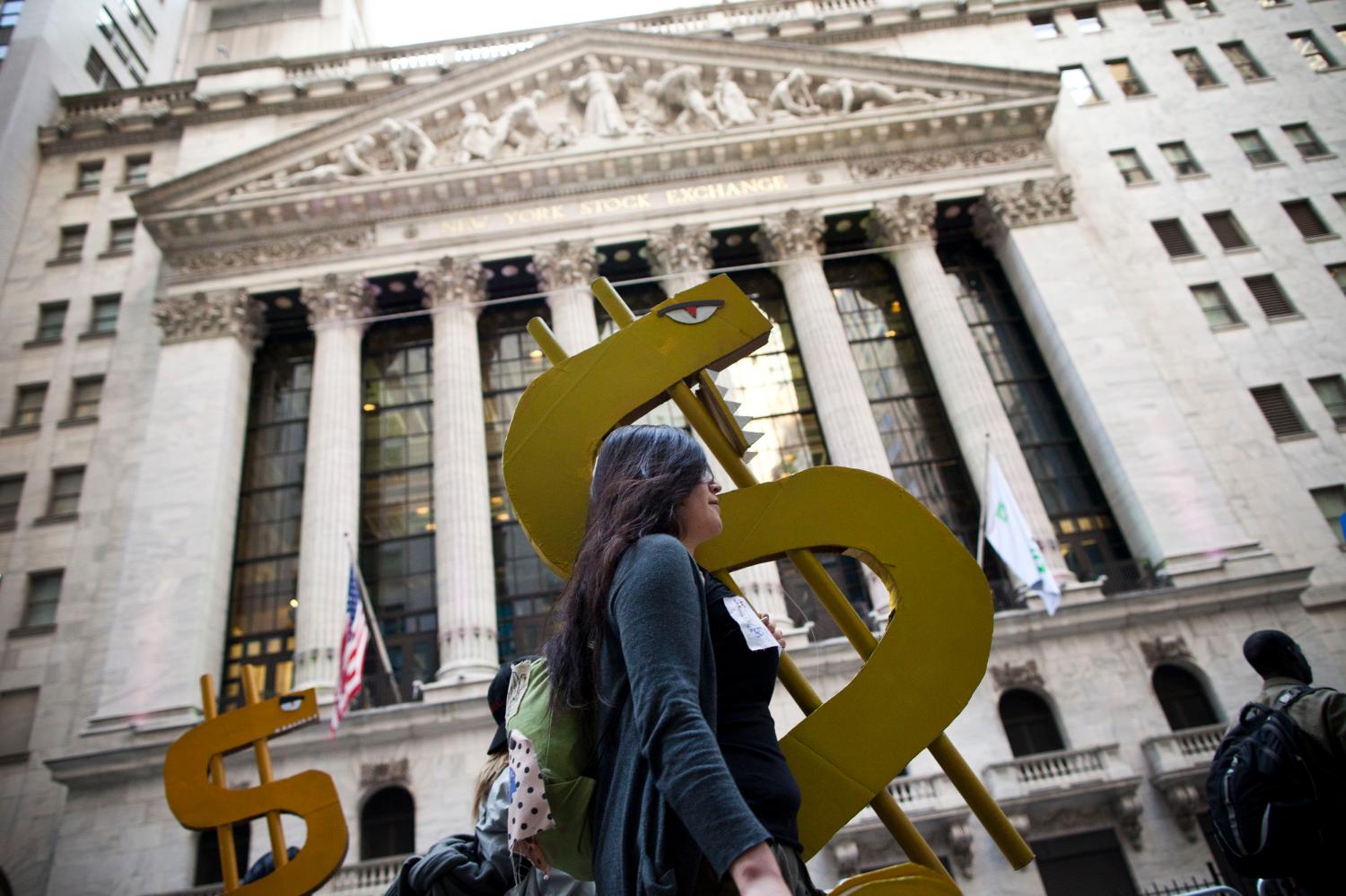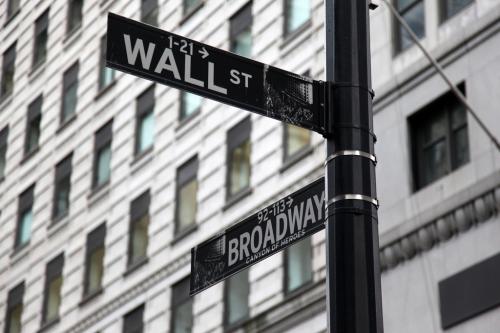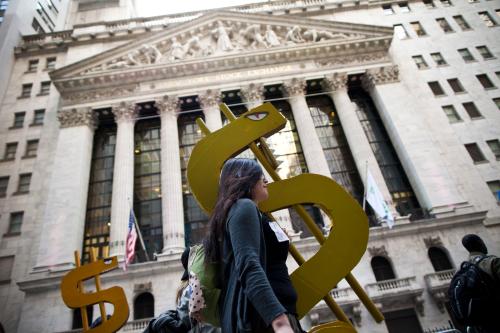This report is part of the Series on Financial Markets and Regulation and was produced by the Brookings Center on Regulation and Markets.
This week the full Senate is likely to consider legislation that for the first time meaningfully amends the Dodd-Frank Wall Street Reform and Consumer Protection Act of 2010. This set of edits to Dodd-Frank has assembled bipartisan backing with a group of moderate Democrats joining most if not all Republicans, providing the bill enough votes to likely pass. The legislation is about more than the small bank relief its supporters focus on, but neither would it gut Dodd-Frank as some opponents claim. Here are three things I like and three that I do not in the bill.
Three Things To Like:
1.) The Process. Chairman Crapo (R-ID) followed the old-school traditional approach to craft bipartisan legislation. He began a joint effort with Ranking Member Brown (D-OH) publicly calling for proposals to improve financial regulation.1 Hearings were held; ideas were publicly vetted and privately negotiated.2 Eventually negotiations between the lead Republican and Democrat on the Committee broke down.
Subsequently a group of moderate Democrats willing to break ranks joined Crapo and cut a deal. Importantly, the deal did not throw away good ideas because some Senators wouldn’t agree to the package. For example, the legislation includes a provision, authored by Senators Scott (R-SC) who supports the overall bill and Senators Reed (D-RI) and Menendez (D-NJ) who opposes it, to streamline and improve a family self-sufficiency program.3It is good to see the package include good ideas regardless of their origin.
The Banking Committee held a long and contentious mark-up where 44 amendments were debated and voted on.4 One of the biggest mistakes in the process that led to Dodd-Frank was when the Republican members of the Banking Committee filed over 400 amendments5 and then refused to offer a single one at the Committee’s mark-up. The Republican failure to put forward and debate their ideas did no one favors. It was important that this Committee mark-up feature a full airing of different opinions.
This process stands in sharp contrast to the recent tax bill, or attempts to repeal the Affordable Care Act. It is possible to be displeased with the outcome and question the political and substantive wisdom of Democrats splintering on the important issue of financial regulation, and still appreciate and respect that the so-called ‘regular order’ process of drafting legislation was followed. Hopefully this is the start of a broader trend of a return to regular order.
2) Municipal Debt and Liquidity Regulation (Section 403). Even if a bank has enough capital to weather a storm, if it runs out of liquidity—or is suspected of being illiquid—it can fail in the absence of government assistance. That is why new liquidity rules were enacted after the financial crisis, and required firms to hold High Quality Liquid Assets (HQLA). This first step, equating liquid assets with those of ‘high quality’, coupled with the unique position of the United States as having the only globally significant municipal debt market, eventually led the bank regulators to a mistaken outcome: excluding all municipal debt from qualifying as HQLA. Some municipal debt is high quality and highly liquid—it is a $3.8 trillion market6 with historically low defaults7.
Liquidity and quality are not perfectly correlated even in the corporate debt market where some high-yield lower quality debt is more liquid than some higher quality investment grade debt. This is even more so in the muni market. Some municipal debt is highly liquid but low quality: three types of Puerto Rican debt were among the six most actively traded munis in 20168. Other municipal debt is high quality and rarely traded, but not necessarily any more illiquid during a financial panic. Financial regulators are not the right entities to be parsing through and grading muni debt issuer by issuer.
In the context of a financial panic, a small town’s water system, or the State of Maryland’s dedicated toll revenue bond, is no more likely to be caught up in a financial maelstrom than, say a previously highly rated corporate debt that would have counted as HQLA (e.g. Enron or WorldCom corporate bonds). While there are spreads for buying and selling, a key question should be the variance of the spread during crisis, not the level of spread during good times. Existing spreads can be taken into account in determining haircut levels to apply to the asset; markets that shut down or spreads that explode under stress are the problems to avoid.
The Federal Reserve began to realize this mistake and started to revise their rule to allow some munis to qualify as among the lowest tier of HQLA. The Fed was in a tough position as traditional liquidity metrics favor bigger issuers over smaller, one can readily appreciate is not good politics in the U.S. Senate. Further the OCC and FDIC have not yet changed their positions.
Congress is the ultimate authority in regulating the financial services sector. Finance is a means to the ultimate ends: the productive allocation of capital and credit. While there should generally be a high bar for Congress to get into this level of detail on regulation, munis are substantively and politically important markets that do not exist globally. One down side of increased global coordination of rule making is not perfectly capturing the impact on unique national markets. The muni fix in this legislation strikes a better balance. It makes all investment grade municipal debt eligible as HQLA, but at the lowest end, with the highest haircut. It creates reasonable parity with the treatment of corporate debt.
3) Raising the so-called ‘Bank SIFI’ limit (Section 401). When Dodd-Frank was being drafted in 2009, concerns about moral hazard and conferring a perceived government backstop to banks deemed ‘too-big-to-fail’ (TBTF) were powerful arguments that led policy makers to set an arbitrarily low threshold of $50 billion for a bank to qualify for enhanced prudential standards (often called systemically important financial institutions, or SIFIs). Any bank over $50 billion in consolidated assets was deemed to require enhanced prudential standards, and hence this became the ‘Bank SIFI’ threshold.
The logic at the time was that banks above this line would be allowed to fail without invoking extraordinary governmental assistance. This would make clear to markets that the $50 billion line did not confer ‘TBTF’ status and guard against a funding advantage to being a SIFI bank.9 Critics of Dodd-Frank heavily attacked the creation of this threshold exactly on those grounds—that banks over $50 billion would enjoy a better ride due to implicit government support.10
Eight years later, concerns about moral hazard have been found to be largely overstated, especially at this level. The GAO conducted a comprehensive report and while they found implicit and explicit government support during the financial crisis did confer an advantage, it has gone away in the post crisis world.11Other studies have shown a net negative impact to being over $50 billion, the result of increased regulatory requirements.12 The $50 billion threshold was not indexed for inflation, economic growth, or growth of assets in the financial system. Eventually this figure must increase if only to keep pace with original demarcation line in Dodd-Frank. In reality, a higher number is justified, as was proposed by the Bipartisan Policy Center and even by Congressman Frank.13
The fact that $50 billion is too low, does not mean that $250 billion is the right number. There are legitimate concerns surrounding the $250 billion limit proposed in S.2155. Two that jump out are how it applies to foreign banks operating in the United States and whether the Treasury Secretary and Financial Stability Oversight Committee will change existing thresholds for non-banks accordingly. One provision in S. 2155 that should provide comfort is that it maintains the Federal Reserve’s ability to apply enhanced prudential standards to banks between $100-250 billion, thus providing a failsafe in case problems arise broadly at institutions of this size. However, for the failsafe to work, the Federal Reserve has to have the full legal authority, regulatory will, and proper judgment to act in ways that are likely to be politically unpopular. If Congress is going to delegate the Fed such authority, consistent with prior authority given to the Fed to tailor enhanced prudential regulatory standards appropriately, it ought to make sure that the Fed is able to exercise this authority if needed. The legislation should not set too high a standard or impediments for the Fed to act.
Three Things Not To Like:
1) Missing elements to address consumer protection and that this is not the end of rollback efforts. While it is important that S.2155 does not go backwards in reducing the power of the Consumer Financial Protection Bureau (CFPB) that is not enough. Current leadership at the Bureau is moving the ball in the wrong direction. Recent actions taken by the CFPB are more likely to hurt American families in the short term than any provision in this legislation.14 If Congress can reach bipartisan consensus to rollback some regulations for banks, it ought to be able to reach bipartisan consensus to enhance some regulations to protect consumers, particularly in light of the Equifax and Wells Fargo scandals. The credit reporting system is rife with misaligned incentives that cause direct harm to millions of consumers who suffer because of errors in their credit report they are powerless to fix.15 Fix it by empowering consumers and put real consequences on credit bureaus for mistaken and breached data.
Prior regulatory relief packages such as the Riegle-Neal included new progressive ideas such as establishing community development financial institutions (CDFIs) a program that has successfully brought credit to many underserved areas. Given the needs for greater access to credit for new businesses, the growth of alternative lending, and the lack of a regulatory framework to protect small and new businesses highlighted by the Treasury Department’s 2016 study, this is a missed opportunity to make progress and implement some of these recommendations.
One of the best aspects of S.2155 is that it accepts much of the core Dodd-Frank regime: enhanced prudential standards for the largest banks, a living will and failure resolution regime, and enhanced consumer financial protections. If supporters of the legislation would accept that a modified Dodd-Frank framework establishes a stable end point to the financial regulatory response to the greatest crisis of our generation, then the legislation would be far easier to support.
I, and many other advocates of financial regulation, would feel differently about the prospects of enactment of S.2155 if its passage would mark an end to major attempts to rollback Dodd-Frank. Unfortunately, it seems to just be the biggest change that can pass Congress, with Dodd-Frank opponents ready to come right back and try for more. Acting CFPB Director Mick Mulvaney was recently reported as calling this legislation a ‘beach head’ for additional changes.16 Congressional appropriations bills regularly attempt to undermine Dodd-Frank relying on filibusters by Democrats to defeat them. If the bipartisan deal coalition that stood behind S.2155 would also stand behind the rest of Dodd-Frank, and agree to move on, it would provide certainty to market participants, and allow Congress to turn to a host of other important areas to make progress, such as revamping our nation’s outdated and inefficient anti-money laundering regime.
2) Sowing seeds of increased systemic risk (Section 402). The lack of simplicity in bank capital regulation is one of the inherit weaknesses of the risk-based capital regime that has come to dominate international bank capital rules (known as BASEL III) and stress tests. Combatting this complexity is the simple leverage ratio—a fraction of a bank’s capital and liabilities. Over time policy makers, economists, and regulators have tended to gravitate to either risk-based or simple-leverage regimes. The correct answer is that they need to work together17—much like how you can eat elegantly with two chopsticks, but with just one you are simply stabbing at your food. Dodd-Frank and BASEL III wisely increased capital requirements for both metrics, although some believe it went too far.
Herein lies the problem with Section 402. The legislation attempts to modify the leverage ratio by excluding one type of activity, certain custodial assets from being counted. This activity spikes during crises, and under the new stricter leverage ratio, new capital may be required to accept custodial assets. This can be expensive and difficult to acquire during the stressed times that result in the spike of activity. Hence, the legislation removes these custodial assets from the supplementary leverage ratio.
However, the bill does not do that for all banks. Rather it singles out the two banks whose primary business is custodial, for this regulatory benefit. Given that there are 30+ banks offering custodial services, changing regulation to benefit the two largest custodial banks will tilt the field toward them. Increasing concentration in an activity that is systemically important increases systemic risk. Almost every metric of systemic risk discusses concentration of systemic activities among their top five key metrics for systemic risk.18
There are two logical positions to address this problem. The first is to agree that certain custodial assets should not be counted for the leverage ration test. In that case, the policy should treat similar activities equally for all financial institutions for regulatory purposes. This would create a level playing field.
The second logical position is to keep the leverage ratio simple and not take this activity away. Removing custodial assets from the calculation for the simple leverage ratio moves us down a slippery slope. What other assets are super-safe enough to be removed? The current definition could include assets such as Greek sovereign debt, which do not appear super safe. One of the key values of the leverage ratio is its lack of judgment of risk by regulators. After all, financial crises occur when everyone, regulators included, misjudge risk.
I agree and prefer the simplicity of the leverage ratio remain just that. But even if you take the other side of that position, and want to remove it, you should support removing it for everyone. As former FDIC Chair Sheila Bair wrote, “Section 402 will create an uneven playing field by giving big systemic banks a special capital break not applicable to community and regional institutions.”19 As currently written this section could be a hidden time bomb that exacerbates systemic risk during the next crisis.
3) Elimination of Anti-Racial Discrimination Data Reporting (Section 104). Racial discrimination in lending, particularly real estate lending is sadly still a reality. For decades the federal government required data be reported under The Home Mortgage Disclosure Act (HMDA) as a powerful tool to help deter and detect racism. This legislation raises the threshold for which mortgage lenders do not need to collect of file HMDA data by more than 20 times. Doing so will eliminate data from approximately 5,400 or 85 percent of banks in the country.20 This loss of data will make it particularly difficult in more rural parts of the country where smaller lenders may comprise more than a quarter of the market.21
Reducing data from smaller institutions will also skew existing HMDA data to give regulators, policy makers, and researchers a less accurate representation of what is happening. One of the biggest economic advantages that smaller and community banks provide America’s economy is an alternative way to allocate credit based on greater knowledge of their community. This is particularly useful for people who do not fit into traditional credit boxes. Eliminating the data from how community banks provide mortgage credit to people of color makes us all worse off and will ultimately hinder smaller banks from better telling their success story in helping to combat the historic and current patterns of racial disparity and discrimination in lending.
Conclusion
There are other provisions of this legislation that deserve scrutiny. Large portions of the bill deal with housing more than bank regulation. Equally important are potential changes to core elements of financial reform that are not touched, such as changes to the CFPB. Like many compromise pieces of legislation, it may be hard to identify anyone who supports every provision in the bill. However, it appears as if there is enough of a consensus within the Senate that the package may pass. While Dodd-Frank ultimately attracted three Republican Senators support to provide it the filibuster majority it needed, this legislation appears headed to a higher number. However, it is unlikely that it will reach the 74 vote super-majority received by the Emergency Economic Stabilization Act of 2008, better known by the program it created: TARP. Ironic that such an unpopular bill could produce a larger majority than anything that has come after it. We still are living in a world polarized by the financial crisis and the response to it.
-
Footnotes
- U.S. Senate Committee on Banking, Housing, and Urban Affairs. Senators Announce Agreement on Economic Growth Legislation [Press Release]. November 13, 2017
- U.S. Senate Committee on Banking, Housing, and Urban Affairs. Crapo Statement at Markup of S. 2155, the Economic Growth, Regulatory Relief and Consumer Protection Act [Press Release]. December 5, 2017.
- Economic Growth, Regulatory Relief, and Consumer Protection Act, S.2155, Section 306, 115th Cong. 2018.
- Ernst & Young, Tax News Update. Senate Banking Committee approves Bipartisan package of regulatory relief provisions, 16-7. December 6, 2017.
- Richert, Catharine. Politifact. “Corker claims the financial regulation got a speedy vote.” April 25, 2010.
- CNBC. “US municipal bond market ticks up to $3.8337 trillion in Q4, Fed says.” March 2017.
- Moody’s Investor Service, Global Credit Research. Moody’s US Municipal Bond Rating Scale. November 2002.
- Electronic Municipal Market Access Municipal Trade Statistics – Most Active Securities and Issuers. Most Active Securities Based on Par Amount Traded. 2016.
- Balasubramnian, Bhanu and Cyree, Ken. The End of Too-Big-to-Fail? Evidence from Senior Bank Bond Yield Spreads Around the Dodd-Frank Act. June 23, 2012.
- Kupiec, Paul. The Hill. “Dodd-Frank doesn’t end ‘too big to fail’” July 30, 2014.
- U.S. Government Accountability Office. Government Support for Bank Holding Companies: Statutory Changes to Limit Future Support Are Not Yet Fully Implemented. November 14, 2013.
- The Clearing House. Working Paper No. 3: Assessing Funding Costs and the Net Impact of Government Policy on Large Banks. July 2014.
- Ryan, Peter. The Bipartisan Policy Center. Raising the Bank “SIFI Threshold” Would Make the Financial System Safer. April 16, 2014
- Klein, Aaron. The Brookings Institution. “Why the CFPB showdown threatens the independence of financial regulators.” November 28, 2017.
- Klein, Aaron https://www.cnbc.com/2017/09/27/the-real-problem-with-credit-reports-is-the-astounding-number-of-errors-equifax-commentary.html
- Cheung, Brian, S&P Global, covering Mulvaney speech before US Chamber of Commerce, March 1, 2018.
- Klein, Aaron. The Brookings Institution. “Risk weights or leverage ratio? We need both.” December 22, 2016.
- Federal Reserve Bank of Cleveland. Sizing Up Systemic Risk. August, 23, 2017.
- Blair, Sheila. The Wall Street Journal. “Congress Flirts With Disaster on Bank Leverage Ratios.” February 12, 2018.
- Americans for Financial Reform. Opposition Letter to S.2155. December 4, 2017.
- National Community Reinvestment Coalition. Estimates of the Impact on the Collection of new HMDA data by a National 500 Closed-End Mortgage Loan Threshold.






